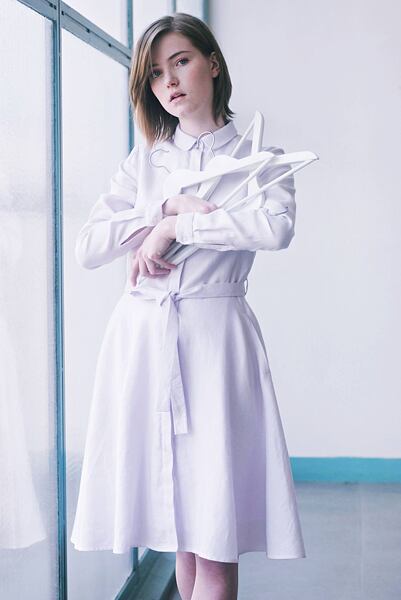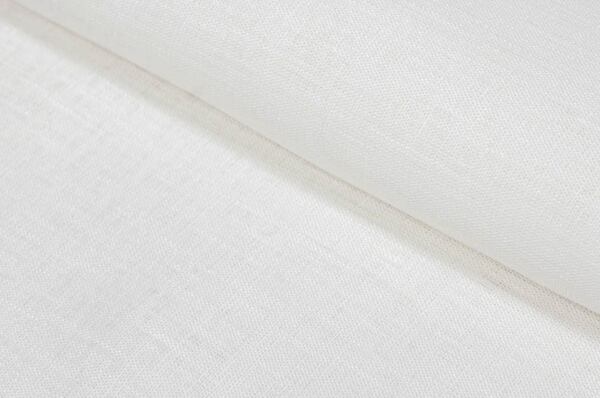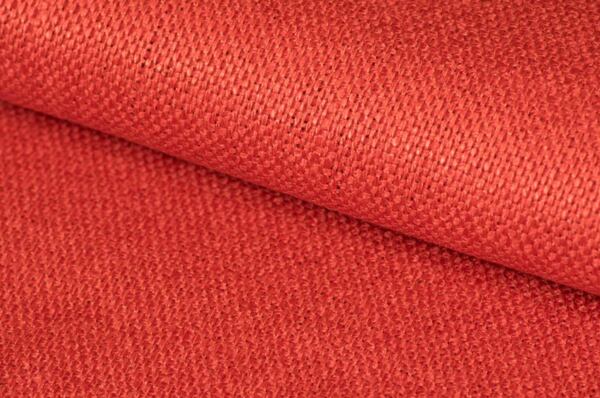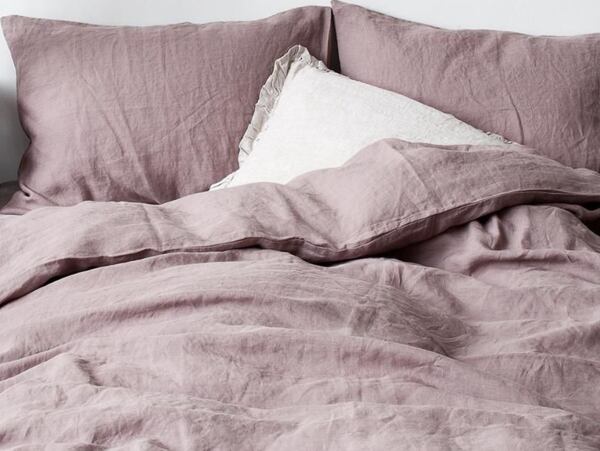
Linen is one of the “big four” natural textiles (the others are cotton, silk, and wool). It’s an old friend—you may have some at home—but seems to get less attention than the others. That doesn’t seem fair, because linen and wool were what everyone dressed in for millennia, until cotton came along. However, there’s been a renewed interest in linen recently and it certainly hasn’t breathed its last.
Linen is no longer the rough, countrified cloth that you may imagine. Advances in technology make today’s linen fabrics more comfortable and softer to the touch. The bulk of our linen fabrics have been specially softened, making them great for comfortable everyday clothing. We deal only in long staple linen, which means our linen fabrics are made from longer flax fibers than the short staple linen commonly sold in North America. Long staple linen offers greater durability and a more sophisticated look—it’s smooth with a lovely sheen and distinctive drape that short staple lacks. As a matter of fact, it’s not unheard of for an item made of long staple linen to last for a century or more with minimum signs of wear and tear.
How linen is made
Linen is a plant-based material made from the stalks of the flax plant (Linum usitatissimum), specifically from bast, the inner part of the stalk. In this way, linen is like hemp, ramie, or jute, which are also bast materials.
Here in Bohemia, flax fields bursting with blue flowers that would later yield little round seed pods, were still a common sight well into the 1990s. The cultivation of flax for producing linen has been abandoned gradually as profits dwindled. A similar scenario played out in neighboring Slovakia and other places in Europe.

The largest textile flax producers—the type of flax used to make linen fabric as opposed to linseed oil—are currently Russia, Ukraine, China, and the EU (specifically France, Belgium, and Ireland). The Irish, Italian, and Belgian linens are considered the best in the world.
Here in the Czech Republic linen seems to be making a comeback, and the Bohemian linen we carry is woven locally using (for now at least) imported materials. We hope one day to be able to offer linen that is entirely of local origin.
Linen is harvested in such a way as to preserve the longest stalk possible—the classic method is to pull it out by the roots. In the first phase of processing, the excess parts of the stalk have to be stripped away. First the dried stalks are threshed to remove the seeds and then soaked in water, where bacteria break down the pectin that hold the bast fibers together, a process called retting. The retting process can be accelerated using chemicals, but then it’s not as ecological or as kind to the fiber.
The next step is scutching, or stripping away the woody part of the stalk. The bits of woody fiber waste that come off can be put to use as a filler in insulation. The bast fiber is then combed, this was once done by hand with a steel comb called a hackle, but today a machine does the job. Any fibers that are too short or tangled after combing are put to use in insulation, rope making, upholstery, and even for making paper.
The flax plant, unlike the cotton plant, is used in its entirety. Its cultivation is also more ecological because flax doesn’t require as much fertilizer or pesticide. The drawback is a lower yield—a field of cotton produces three times more than a field of flax.
Properties of linen
Linen has many benefits and few drawbacks. Like other natural materials, it tends to wrinkle, but that’s a problem that can be remedied. A lot depends on the thickness and suppleness of the fabric, so a heavy linen canvas or a blend of linen with cotton, rayon, or elastane won’t wrinkle as much. But wrinkling is such a part of the linen “look” that it really can add to the charm of a garment, especially in casual clothing.
Linen’s other traditional drawback is a certain roughness or scratchiness, but that’s not inevitable either. Raw linen is stiff and rough (and durable) but modern processing can soften it considerably. Most of our linen fabrics have been softened and are very comfortable. We also carry linen blends with cotton or silk that are even smoother and softer. What’s more, linen gets softer every time you wash it.

- The durability of linen is one of its greatest benefits. Linen stands up to frequent wear and tear and regular laundering. While especially fine linen fabrics may be damaged if handled roughly, they’ll still hold out better than a similar cotton or silk. You’ll come to value this quality especially in bed linens, dish towels, and other household linens. Bleached or undyed linen can handle boiling and can be dried in direct sunlight… just remember that such handling is a bit drastic and that your fabric may shrink or lose its shape. Linen clothing should be washed at 40°C, maximum 60°C (for whites and undyed pieces) and boiling should be reserved for items such as dish towels and handkerchiefs.
- As a rule, linen fabrics (except in the lightest weights) can take some pretty rough handling—bleaching, disinfection, extra strong laundering agents, scrubbing on a washboard, rinsing in a creek.
- Linen doesn’t attract pests (no need to worry about moths) and withstands mold and bacteria. In situations where cotton gets musty or succumbs to mildew, linen holds its own.
- Linen dries quickly (faster than cotton) and it breathes and feels cool to the touch. This makes it great for summer clothes. It simply feels cooler than cotton.
- Linen stays fresh longer and won’t trap unpleasant odors—another thing it’s better at than cotton. You’ll appreciate that when you’re travelling, camping, or playing at a historical reenactment—if you can’t wash your clothes, just hang them to air out.
- Linen takes dyes well. If you’ve browsed our linen fabrics, you’re bound to have noticed the great color palette. Linen fabrics come in a range of brights and muted colors, natural tones, shot weaves, and interesting prints too.
PATTERNED LINEN
What’s linen best for?
There is a wealth of uses for linen fabric, yarn, and thread in all kinds of households.
Linen clothing
Linen can be used for pretty much any article of clothing. Sturdier fabrics like our heavy linen are perfect for a tailored sheath dress or a suit. A pale linen suit is a traditional summertime choice for occasions where a guy has to look his best, from a friend’s wedding to an informal business meeting. Likewise, a simple linen dress in a muted color is a great choice for the office and way more comfortable than polyester.
If your linen garment needs a lining, we recommend reaching for a silk lining (such as habotai or silk serge twill) or a silk-cotton voile to preserve the item’s breathability and coolness.
Medium weight linen fabrics are great for skirts, dresses, tunics, trousers. A nice loose pair of linen pants are cooler in hot weather than shorts are.
Our light linen makes wonderful blouses, tunics, airy dresses, or layered garments, as well as floaty scarves.


More at home in a t-shirt? Then have a look at our linen jersey. You can use this linen knit just as you would any cotton jersey. A linen tee is stretchy and airy, a lot like a cotton tee, but it dries faster and it breathes more, making it a better choice for summer.
LIGHT LINEN
Linen for special occasions
When you imagine a wedding dress, what comes to mind? A lavish duchesse satin and yards of gorgeous lace? But what if you’re planning a romantic country wedding or a simple backyard ceremony? A heavyweight linen is a wonderful solution for full, gathered skirts that (unlike silk) can be starched or simply layered over a petticoat. A modest linen gown trimmed in bobbin lace, with simple embroidery or without any decoration at all is lovely as well as practical—after the wedding you can just throw it in the wash, maybe dye it, and keep wearing it all summer long.
While you probably won’t see linen in fancy ballgowns or evening wear, it does find its way in at the corners of high society. A little black dress done in linen can be dressed up with the right accessories for a fancy afternoon garden party and then trotted out the next day for a trip into town.



An elegant linen dress by Lucie Cetkovska Komarkova

Linen around the house
Durable, easy-to-care-for linen is great around the house, from the kitchen to the bedroom.
Linen dishtowels have been highly prized for generations—they’re absorbent, dry quickly, and can stand boiling in a big pot on the stove. They’re readily available on the market today but they’re also a really easy DIY project—just reach for heavy linen or a linen twill or linen herringbone (the sturdy weave enhances linen’s natural durability). Store-bought dishtowels have usually been calendered (finished in a roller) so they have to be washed before first use, but then their absorbency is second to none.


Linen handkerchiefs and towels are, unfortunately, rarer and more expensive than cotton. But handkerchiefs are easy to make yourself. If you prefer cloth handkerchiefs to paper tissues, linen is more sanitary and lasts longer than cotton. It’s easy to wash, disinfect, and iron.
Easy-to-care-for linen is great for placemats, tablecloths, and even infant bibs.
Linen is more than just practical, however. It’s also great for decorating. Make yourself some gorgeous linen curtains: For diaphanous curtains try our light linen in white or a pale pastel and for heavier drapes chose our medium linen or heavy linen in any shade you like. Simple solid colors will suit most interiors, and curtains in natural tones will add a rustic touch. A subtle pattern, like herringbone or muted stripes, is elegant and will elicit complements without being too flashy.
Linen is an excellent choice for pillowcases. It not only makes a lovely accent, but for those who actually put their throw pillows to use it’s easy to care for; linen can be tossed into the washer whenever needed.
And what about the bedroom? There’s a reason why bed linens are called just that. Linen is a classic material for use in bed sheets and duvet covers. Linen breathes and wicks away moisture, so you’ll sleep better than ever. It’s surface, however, is a bit rougher and may not be suitable for those with really sensitive skin.
Linen for folk costumes and period garments
If you’re a history buff or involved in historical reenactment, linen needs no introduction. Whether your interest is in the middle ages or you sew folk costumes, you won’t get far without it.
For historical and period clothing we offer linen in natural tones as well as a range of colors, so it’s up to you whether you want a fabric that’s been dyed using modern methods or would rather do it yourself. Our light linen is good for undershirts and slips, medium and heavy linen for outer layers, capes, and accessories (bags, sacks). If you don’t mind a touch of modern innovation, we also sometimes have a waterproof linen that’s great for covering wagons or booths.
For hand-sewing linen garments, use our linen thread.

Here in the Bohemian countryside, linen and wool were practically the only fabrics people dressed in. Everyday clothing and kroj (folk costumes) were made primarily of linen until the dawn of the industrial revolution and the gradual rise of cotton.
Linen yarn and thread
The linen thread you’ll find in our e-shop is very popular among our customers for hand-sewing historical costumes. It’s also great for making bobbin lace or crocheting and making small ornaments.
Linen yarn, used for knitting, doesn’t number among our wares. But if you enjoy knitting, you’re probably familiar with it. It is used most often for knitting and crocheting summer scarves, light sweaters, and bags.
LINEN IN TWILL WEAVE
The history of linen
As I’ve mentioned above, linen is an ancient material. How ancient? Archeological finds show that people knew how to get fiber from wild flax and turn it into primitive textiles 30,000 years ago. The ancient Mesopotamians cultivated flax and there was an active linen industry in ancient Egypt, although linen was only worn by the wealthy both in life and after death (embalmers used linen bandages to wrap the body of the deceased). Those embalming wraps survived intact, by the way. The museum in Belfast has a 2500-year-old mummy that was found wrapped in perfectly preserved linen.
Flax was cultivated and processed into linen by the ancient Phoenicians, Greeks, and Romans. They wore it and used it to make sacks and sails. In the middle ages, flax made its way to Europe, where it thrived in the cool, damp climate. In the 15th century, the invention of the spinning wheel made the production of yarn much faster. Linen fabric, previously the domain of the wealthy, started to spread to the rest of the population. Growers and processors of flax sold part of what they made and used the rest to make clothing, flour sacks, ropes, and household goods.
With the advent of the industrial revolution in the 19th century, the production of linen yarn and fabric increased, and linen was used to make just about everything from undergarments and outerwear to bed linens, dishtowels, and handkerchiefs. But then cheap cotton started to flow into Europe from the colonies, competing with linen and practically taking over the market. That’s still pretty much the case today, but the low cost of cotton is taking a toll on the environment. Cotton cultivation requires a large amount of water and chemicals, whereas flax is much less demanding and more resistant to pests.
That’s another reason why linen is making a comeback today. Consumers appreciate its lower ecological footprint and are willing to pay a bit more for the superior durability of linen clothing (it completely out-classes the cheap cotton fabrics used in “fast fashion”). Here at Sartor we hope that this is more than just a temporary trend and that someday we’ll see the return of those fields of blue flowers!
HEAVY LINEN
Interested in linen?
Not sure which color or weight is right for you?
we’ll be happy to send you a free fabric sample. No strings attached.










Comments(0)